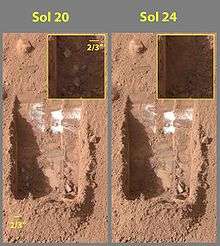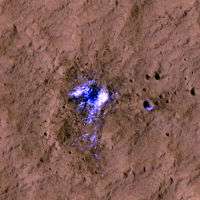Mars Scout Program
The Mars Scout Program was a NASA initiative to send a series of small, low-cost robotic missions to Mars, competitively selected from innovative proposals by the scientific community. The program had an array of missions destined to reach Mars, and study it at relatively low costs. Each Scout project was to cost less than US$485 million. The Phoenix[1] lander and MAVEN orbiter were selected and developed before the program was retired in 2010.[2]
First Scout mission


The first robotic spacecraft in this program was Phoenix, a lander originally intended for the canceled Mars Surveyor mission but adapted to the new mission. Phoenix was launched on August 4, 2007, and landed on the icy northern polar region of the planet on May 25, 2008. Phoenix was designed to search for environments suitable for microbial life on Mars, and to research the history of water there. The 90-day primary mission was successful and the overall mission was concluded on November 10, 2008, after engineers were unable to contact the craft. The lander last made a brief communication with Earth on November 2, 2008.
Phoenix was one of four finalists selected out of 25 proposals.[3] The four finalists were Phoenix, MARVEL, SCIM (Sample Collection for Investigation of Mars), and the ARES ("Aerial Regional-scale Environmental Survey") Mars airplane.[3] SCIM was a sample return mission that would have used a free-return trajectory and aerogel to capture Mars dust and return it to Earth[3] (see also: the Stardust mission). MARVEL was an orbiter that would have searched for volcanism as well as analyzed various components of the Mars atmosphere.[3] The name is an acronym for Mars Volcanic Emission and Life Scout, and it was intended to detect gases from life if it was there.[3] ARES was an aircraft concept for Mars to study the lower atmosphere and surface.[3]
The Phoenix lander basic design was further utilized for the Discovery' program InSight for Mars.
Second Scout mission
On September 15, 2008, NASA announced that it had selected MAVEN for as the second mission.[4][5][6] This mission was budgeted at no more than US$475 million.[7] The mission was launched on November 18, 2013 and it achieved Mars orbit on September 22, 2014.
Multiple lines of evidence suggest that Mars lost most of its atmosphere billions of years ago. The MAVEN orbiter is studying the current rate of atmospheric loss with an emphasis on the role of the solar wind, whose rapidly moving ions and magnetic field may be responsible for Mars' current condition.
End of program
In 2010, the NASA Science Directorate announced that the Mars Scout program would be incorporated into the Discovery program, which was re-scoped to allow Mars missions to be proposed.
Previous candidates
Here are some previous missions that may have been considered for the Mars Scout Program:[9][10]
| Mission Name | Description |
|---|---|
| The Great Escape (TGE) | The mission would have directly determined the basic processes in Martian atmospheric evolution by measuring the structure and dynamics of the upper atmosphere. In addition, potentially biogenic atmospheric constituents such as methane would have been measured. The principal investigator is Alan Stern, Southwest Research Institute, Boulder, Colorado. Southwest Research Institute, San Antonio, would have provided project management.[11] |
| Artemis | This mission would launch up to four saucer-shaped landers, two feet (0.61m) in diameter, from a "mother ship" orbiting Mars. Each would parachute onto the surface, analyzing the soil and atmosphere. Two of the four landers would be targeted at the polar regions. |
| ARES | This mission concept proposed to send an unmanned airplane into the Martian atmosphere to observe the planet.[12][13] |
| Chronos | This mission would consist of a probe designed to melt through a polar ice cap using heated jets. It would travel up to 100 yards (91m) below the surface, analyzing the melted water to determine the climatic history of Mars.[14] |
| KittyHawk | This mission would create three or four winged gliders with approximately six-foot (1.83m) wingspans and would explore the Valles Marineris canyon system. The gliders would carry infrared spectrometers and cameras. |
| MOO | With infrared telescopes on Earth and a spectrometer on the Mars Express Orbiter, methane was discovered in the Martian atmosphere. The presence of methane on Mars is very intriguing, since as an unstable gas it indicates that there must be an active source of the gas on the planet. The latest research suggests that the methane destruction lifetime is as long ~4 Earth years and as short as ~0.6 Earth years.[15] In either case, the destruction lifetime for methane is much shorter than the timescale (~350 years) estimated for photochemical (UV radiation) destruction.[15] The Mars Organics Observer would use an orbiter to characterize the Martian methane: where it is being emitted, how much is being emitted and how often it is being emitted. |
| The Naiades | Named for nymphs of springs, lakes, and rivers from Greek mythology, this mission would send two landers to a region which likely holds groundwater. The landers would search for the groundwater using low-frequency electromagnetics and other instruments. |
| SCIM | A sample return mission that would briefly pass into the Martian atmosphere to scoop up about 1000 dust grains and a few liters of air without slowing from escape velocity. |
| THOR | Similar to NASA's Deep Impact, this mission would impact two copper spheres into Mars' surface to create craters in a region known to have water ice, and maybe liquid water, a few meters under the surface. An accompanying orbiter would analyze the craters from orbit. Although this mission was not selected, ice was later observed in fresh natural impacts.[16] |
| Urey | This mission calls for a lander/rover pair designed to analyze the ages of rocks. It would be targeted for the Cerberus Highlands region, and would look for specific minerals to help scientists compare the cratering of Mars with that of the Moon. |
| MARVEL | Orbiter with spectrometers would look for volcanic emissions and life |
| CryoScout | Melt probe for ice caps |
| Pascal | 24 mini weather stations. Also proposed in the Discovery Program.[17] |
| MEO | Mars Environmental Orbiter—study atmosphere and hydrology |
| MACO | Mars Atmospheric Constellation Observatory—a network of microsatellites study the atmosphere |
| MSR | Mars Scout Radar—Synthetic Aperture Radar (SAR) to study sub-surface |
| Hailstorm | Six Deep Space 2-like hard impact landers with subsurface penetrators[18] |
Gallery
- Icy Clouds & Crater
 Ice in a fresh Martian impact crater
Ice in a fresh Martian impact crater Ice clouds in the Martian arctic
Ice clouds in the Martian arctic
See also
References
- ↑ Nelson, Jon. "Phoenix". NASA. Retrieved February 2, 2014.
- ↑ NASA's Scout Program Discontinued.
- 1 2 3 4 5 6 NASA selects four Mars Scout mission concepts for study
- ↑ "NASA Selects 'MAVEN' Mission to Study Mars Atmosphere". NASA. 2008-09-15.
- ↑ NASA Selects Proposals for Future Mars Missions and Studies
- ↑ "NASA Delays Mars Scout Mission to 2013". NASA. 2007-12-21.
- ↑ JPL.NASA.GOV: News Release
- ↑ Jones, Nancy; Steigerwald, Bill; Brown, Dwayne; Webster, Guy (October 14, 2014). "NASA Mission Provides Its First Look at Martian Upper Atmosphere". NASA. Retrieved October 15, 2014.
- ↑ Scout Missions - Mars News
- ↑ NASA SELECTS FIRST MARS SCOUT CONCEPTS FOR FURTHER STUDY (2001)
- ↑ Southwest Research Institute proposal for Mars Scout orbiter mission selected for study by NASA
- ↑ "ARES - A Proposed Mars Scout Mission". NASA. 2007-01-17.
- ↑ ARES Mars Aircraft youtube.com video of model and test flight
- ↑ CHRONOS - A Journey Through Martian History
- 1 2 Mumma, Michael J. (20 February 2009). "Strong Release of Methane on Mars in Northern Summer 2003" (PDF). Science. 323 (5917): 1041–1045. Bibcode:2009Sci...323.1041M. doi:10.1126/science.1165243. PMID 19150811.
- ↑ Neil F. Comins -Discovering the Essential Universe (2012) - Page 148
- ↑ R. Haberle, et al. - The Pascal Discovery Mission: A Mars Climate Network Mission (2000)
- ↑ Hailstorm Proposal (.pdf)
External links
- Mars Scout 2 Mission Profile by NASA's Solar System Exploration
- Mars Scout 3 Mission Profile by NASA's Solar System Exploration
- Scout Missions NewsWire



.jpg)
.jpg)
